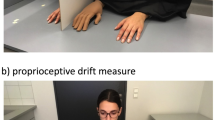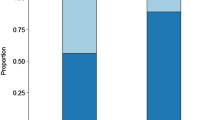Abstract
We investigated mental representations of body parts and body-related activities in two subjects with congenitally absent limbs (one with, the other without phantom sensations), a wheelchair sports group of paraplegic participants, and two groups of participants with intact limbs. To analyse mental representation structures, we applied Structure Dimensional Analysis. Verbal labels indicating body parts and related activities were presented in randomized lists that had to be sorted according to a hierarchical splitting paradigm. Participants were required to group the items according to whether or not they were considered related, based on their own body perception. Results of the groups of physically intact and paraplegic participants revealed separate clusters for the lower body, upper body, fingers and head. The participant with congenital phantom limbs also showed a clear separation between upper and lower body (but not between fingers and hands). In the participant without phantom sensations of the absent arms, no such modularity emerged, but the specific practice of his right foot in communication and daily routines was reflected. Sorting verbal labels of body parts and activities appears a useful method to assess body representation in individuals with special body anatomy or function and leads to conclusions largely compatible with other assessment procedures.


Similar content being viewed by others
References
Abramson AS, Feibel A (1981) The phantom phenomenon: its use and disuse. Bull NY Acad Med 57:99–112
Anema HA, Kessels RPC, de Haan EHF, Kappelle LJ, Leijten FS, van Zandvoort MJE, Martine JE, Dijkerman HC (2008) Differences in finger localisation performance in patients with finger agnosia. Neuroreport 19:1429–1433
Benton AL (1959) Right-left discrimination and finger localisation: development and pathology. Hoeber-Harper, New York
Berlucchi G, Aglioti S (1997) The body in the brain: neural bases of corporeal awareness. Trends Neurosci 20:560–564
Berlucchi G, Aglioti S (2010) The body in the brain revisited. Exp Brain Res 200:25–35
Bläsing B, Tenenbaum G, Schack T (2009) Cognitive structure of movement in classical dance. Psychol Sport Exerc 10:350–360
Braun SM, Beurskens AJ, Schack T, Marcellis RG, Oti KC, Schols JM, Wade DT (2007) Is it possible to use the structural dimension analysis of motor memory (SDA-M) to investigate representations of motor actions in stroke patients? Clin Rehabil 21:822–832
Brugger P, Funk M (2007) Out on a limb: neglect and confabulation in the study of aplasic phantoms. In: Della Sala S (ed) Tall tales about the mind and brain. Separating fact from fiction. Oxford University Press, Oxford, pp 348–368
Brugger P, Kollias S, Müri M, Crelier G, Hepp-Reymond M-C, Regard M (2000) Beyond re-membering: Phantom sensations of congenitally absent limbs. PNAS 97:6167–6172
Carruthers G (2008a) Types of body representation and the sense of embodiment. Conscious Cogn 17:1302–1316
Carruthers G (2008b) Reply to Tsakiris and Fotopoulou “Is my body the sum of online and offline representations?”. Conscious Cogn 17:1321–1323
Cooper LA, Shepard RN (1975) Mental transformations in the identification of left and right hands. J Exp Psychol Hum Percept Perform 104:48–56
Corradi-Dell’Acqua C, Rumiati RI (2007) What the brain knows about the body: evidence for dissociable representations. In: Santoianni F, Sabatano C (eds) Brain development in learning environments: embodied and perceptual advancements. Cambridge Scholar Publishing, Newcastle, pp 50–64
Corradi-Dell’Acqua C, Tessari A (2010) Is the body in the eye of the beholder? Visual processing of bodies in individuals with anomalous anatomical sensory and motor features. Neuropsychologia 48:689–702
Corradi-Dell’Acqua C, Hesse MD, Rumiati RI, Fink G (2008) Where is the nose with respect to a foot? The left posterior parietal cortex processes spatial relationships among body parts. Cereb Cortex 18:2879–2890
Corradi-Dell’Acqua C, Tomasino B, Fink G (2009) What is the position of an arm relative to the body? Neural correlates of body schema and body structural description. J Neurosci 29:4162–4171
De Vignemont F (2010) Body schema and body image–pros and cons. Neuropsychologia 48:669–680
De Vignemont F, Tsakiris M, Haggard P (2005) Body mereology. In: Knoblich G, Thornton IM, Grosjean M, Shiffrar M (eds) Human body perception from the inside out. Oxford University Press, Oxford, UK, pp 147–170
De Vignemont F, Majid A, Jola C, Haggard P (2009) Segmenting the body into parts: evidence from biases in tactile perception. Q J Exp Psychol 62:500–512
Dijkerman HC, de Haan EHF (2007) Somatosensory processing subserving perception and action. Behav Brain Sci 30:189–201
Funk M, Brugger P (2008) Mental rotation of congenitally absent hands. J Int Neuropsychol Soc 14:81–89
Funk M, Shiffrar M, Brugger P (2005) Hand movement observation by individuals born without hands: phantom limb experience constrains visual limb perception. Exp Brain Res 164:341–346
Gallagher S (2005) How the body shapes the mind. Oxford University Press, New York
Gazzola V, van der Worp H, Mulder T, Wicker B, Rizzolatti G, Keysers C (2007) Aplasics born without hands mirror the goal of hand actions with their feet. Curr Biol 17:1235–1240
Giummarra MJ, Gibson SJ, Georgiou-Karistianis N, Bradshaw JL (2007) Central mechanisms in phantom limb perceptions: the past, present and future. Brain research reviews 54:219–232
Grèzes J, Decety J (2001) Functional anatomy of execution, mental simulation, observation, and verb generation of actions: a metaanalysis. Hum Brain Mapp 12:1–19
Haggard P, Wolpert DM (2005) Disorders of body scheme. In: Freund H-J, Jeannerod M, Hallett M, Leiguarda RC (eds) Higher order motor disorders. Oxford University Press, Oxford, pp 261–272
Haggard P, Kitadono K, Press C, Taylor-Clarke M (2006) The brain’s fingers and hands. Exp Brain Res 172:94–102
Hauk H, Johnsrude I, Pulvermüller F (2004) Somatotopic representation of action words in human motor and premotor cortex. Neuron 41:301–307
Head H, Holmes G (1911) Sensory disturbances from cerebral lesion. Brain 34:102–254
Hilti L, Brugger P (2009) Incarnation and animation: physical versus representational deficits of body integrity. Exp Brain Res. doi:10.1007/s00221-009-2043-7
Kinsbourne M, Warrington EK (1962) A study of finger agnosia. Brain 85:47–66
Lander H-J, Lange K (1996) Untersuchung zur Struktur- und Dimensionsanalyse begrifflich repraesentierten Wissens. Zeitschrift für Psychologie 204:55–74
Paillard J (1999) Body schema and body image–a double dissociation in deafferented patients. In: Gantchev GN, Mori S, Massion J (eds) Motor control. Today and tomorrow. Academic Publishing House ‘Prof M. Drinov’, Sofia, pp 197–214
Parsons LM (1994) Temporal and kinematic properties of motor behavior reflected in mentally simulated action. J Exp Psychol Hum Percept Perform 20:709–730
Parsons LM, Fox PT, Downs JH, Glass T, Hirsch TB, Martin CC, Jerabek PA, Lancaster JL (1995) Use of implicit motor imagery for visual shape discrimination as revealed by PET. Nature 375:54–58
Price EH (2006) A critical review of congenital phantom limb cases and a development theory for the basis of body image. Conscious Cogn 94:2367–2374
Reed CL, Farah MJ (1995) The psychological reality of the body scema: a test with normal participants. J Exp Psychol Hum Percept Perform 21:334–343
Reed CL, McGoldrick JE, Shackelford JR, Fidopiastis CM (2004) Are human bodies represented differently from other objects? Experience shapes object representations. Vis Cogn 11:523–550
Schack T (2001) On the structure of movement representations – theoretical assumptions and methodical approach. Motor Control Learn (E-Journal). ISSN: 1439-7919 ISSN: 1439-79191–12; available from: http://www.ejournalbut.de/Journal/index.asp
Schack T (2004a) The cognitive architecture of complex movement. Int J Sport Exercise Psychol 2:403–438 Special Issue Part II
Schack T (2004b) Relation of knowledge and performance in action. J Knowl Manage 8:38–53
Schack T (2010) A method for measuring mental representation. In: Tenenbaum G, Eklund R, Kamata A (eds.) Handbook of measurement in sport and exercise psychology. Human kinetics, Champaign, IL, in press; available from: http://www.uni-bielefeld.de/sport/arbeitsbereiche/ab_ii/publications/schack_pub.html
Schack T, Mechsner F (2006) Representation of motor skills in human longterm memory. Neurosci Lett 391:77–81
Schwoebel J, Coslett HB (2005) Evidence for multiple, distinct representations of the human body. J Cogn Neurosci 17:543–553
Sebanz N, Knoblich G, Prinz W (2003) Representing others’ actions: just like one’s own? Cognition 88:B11–B21
Shiffrar M, Freyd JJ (1990) Apparent motion of the human body. Psychol Sci 1:257–264
Sirigu A, Grafman J, Bressler K, Sunderland T (1991) Multiple representations contribute to body knowledge processing. Evidence from a case of autotopagnosia. Brain 114:629–642
Acknowledgments
The authors would like to thank A.Z. and C.L. and all other participants for their cooperation. We thank Christian Schütz for help with the data acquisition in the wheelchair sports groups, Glenn Carruthers and Adrian J. T. Smith for fruitful discussions and two anonymous reviewers for their helpful comments. This work was partly funded by the Center of Excellence Cognitive Interaction Technology (CITEC) at Bielefeld University.
Author information
Authors and Affiliations
Corresponding author
Rights and permissions
About this article
Cite this article
Bläsing, B., Schack, T. & Brugger, P. The functional architecture of the human body: assessing body representation by sorting body parts and activities. Exp Brain Res 203, 119–129 (2010). https://doi.org/10.1007/s00221-010-2216-4
Received:
Accepted:
Published:
Issue Date:
DOI: https://doi.org/10.1007/s00221-010-2216-4




